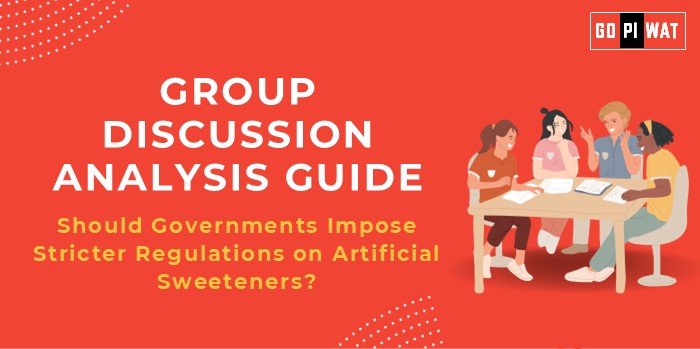📋 Group Discussion (GD) Analysis Guide: Should Governments Impose Stricter Regulations on Artificial Sweeteners?
🌐 Introduction to the Topic
📖 Opening Context
Artificial sweeteners have become a staple in modern diets, especially among health-conscious individuals and people managing conditions like diabetes. However, their safety and long-term health impacts have sparked global debates, making this a pressing issue for policymakers.
📜 Topic Background
Artificial sweeteners were developed to reduce sugar consumption and curb health risks like obesity and diabetes. However, concerns over their potential links to health problems, including cancer and metabolic disorders, have led to calls for stricter regulation.
📊 Quick Facts and Key Statistics
- 💰 Global Sweetener Market Value: $9 billion (2023) – indicating widespread use and market penetration.
- 🌍 Obesity Prevalence: Over 1 billion adults globally, with 39% linked to high sugar consumption (WHO, 2023).
- 📚 Cancer Research Studies: Mixed findings on carcinogenic risks from aspartame and sucralose.
- 🍬 Consumption Rates: 35% of adults in developed countries consume artificial sweeteners regularly.
🤝 Stakeholders and Their Roles
- 🏛️ Governments: Regulate product safety, enforce labeling standards, and oversee public health campaigns.
- 🌍 Health Organizations: Conduct research, issue guidelines, and raise awareness of risks and benefits.
- 🏢 Manufacturers: Innovate products, ensure compliance, and address safety concerns.
- 👥 Consumers: Drive demand and advocate for transparency and safer options.
🏆 Achievements and Challenges
✨ Achievements
- 🍭 Sugar Replacement: Artificial sweeteners help reduce caloric intake and sugar consumption.
- 🩺 Diabetes Management: Beneficial for people requiring blood sugar control.
- 🌟 Innovation in Food Products: Expansion of sugar-free and low-calorie options.
⚠️ Challenges
- 🔬 Health Risks: Potential links to cancer, gut microbiota disruption, and weight gain.
- 🌐 Regulatory Variations: Lack of global consensus on safety standards.
- ❓ Misinformation: Conflicting studies confuse consumers about safety.
🌎 Global Comparisons
- 🇪🇺 The EU: Classifies aspartame as safe but limits daily intake.
- 🇺🇸 The US: FDA approves its use but faces criticism over outdated research.
💡 Structured Arguments for Discussion
- 👍 Supporting Stance: “Governments must prioritize public health by imposing stricter regulations on artificial sweeteners, given the growing evidence of their potential long-term health risks.”
- 👎 Opposing Stance: “Stricter regulations could stifle innovation and limit options for consumers managing diabetes or obesity.”
- ⚖️ Balanced Perspective: “While artificial sweeteners offer significant benefits, governments must enforce stricter standards to address safety concerns and protect public health.”
📈 Effective Discussion Approaches
🔑 Opening Approaches
- 📊 Cite a Compelling Statistic: “Over 1 billion adults globally struggle with obesity, partly due to high sugar consumption, making artificial sweeteners a double-edged sword.”
- ⚡ Highlight a Recent Controversy: “Aspartame’s re-evaluation by health authorities underscores the need for updated safety standards.”
🤔 Counter-Argument Handling
- 📚 Present data-driven rebuttals, emphasizing ongoing research and safety protocols.
🔍 Strategic Analysis of Strengths and Weaknesses
- 🌟 Strengths: Lower calorie intake, diabetes-friendly, and widespread availability.
- ⚠️ Weaknesses: Potential health risks, regulatory inconsistencies, and public mistrust.
- 🚀 Opportunities: Develop safer alternatives and educate consumers.
- ⚡ Threats: Rising scrutiny and potential bans.
📚 Connecting with B-School Applications
- 🌐 Real-World Applications:
- 📣 Explore marketing strategies for health-conscious products.
- 📋 Assess public health policies and their market impacts.
- 💬 Sample Interview Questions:
- 🧠 “How can businesses balance innovation with health regulations?”
- 📊 “Evaluate the role of consumer awareness in driving regulatory changes.”
- 💡 Insights for B-School Students:
- 📊 Focus on policy impacts on markets, consumer behavior, and innovation.


